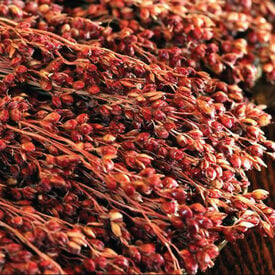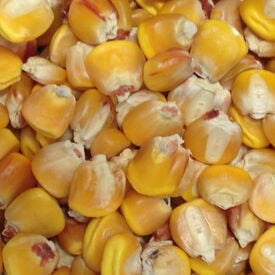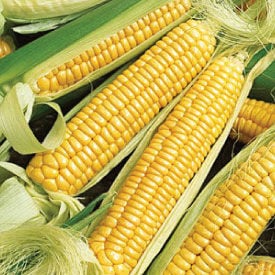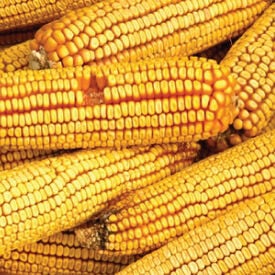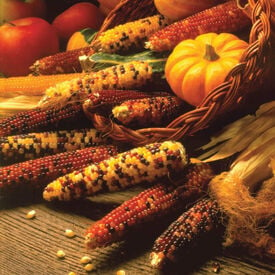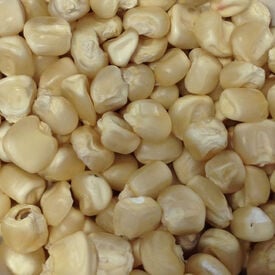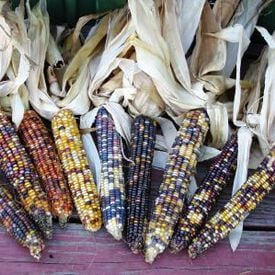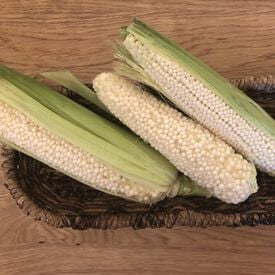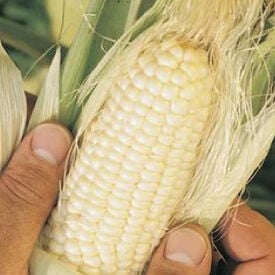Red Head broom corn produces a tall spray of seed heads at the top of the plant, laden with shiny red tiny sorghum seeds that birds love. Incorporate seeds into edible bird-feeder wreaths or leave the 2–3' sprays intact to add variety to traditional fall decorations.
Green Field corn produces an abundance of tall (8-10') stalks with 8-9" long ears. Developed from Reid's Yellow Dent, this corn produces bright yellow, long and narrow 14-kernel row ears. Green Field was the name of the farm that this corn was first produced on. Reported yields of 190 bu/acre in the boot heel area of MO.
Hickory King Yellow corn is a traditional heirloom variety renowned for its large, yellow kernels and excellent versatility in the kitchen. Originally from the Appalachian region, this corn is prized for its rich, starchy texture and high yield. It’s commonly used for making cornmeal, grits, and flour, as well as for hominy, and its large kernels make it perfect for grinding into fine or coarse products. Hickory King Yellow corn is also known for its tall, sturdy plants that are adaptable to a range of soil types and growing conditions, making it resilient in both cooler and warmer climates. As an open-pollinated variety, it is well-suited for sustainable farming and seed-saving, allowing farmers and gardeners to preserve this piece of agricultural heritage. With its adaptability, high yield, and diverse culinary applications, Hickory King Yellow corn remains a popular choice for those seeking a reliable, flavorful heirloom crop.
Early Golden Bantam corn, also known simply as Golden Bantam, is a classic and iconic sweet corn variety with a rich history dating back to the early 20th century. Introduced in 1902 by W. Atlee Burpee, it quickly became one of the most popular corn varieties in the United States. This heirloom corn is cherished for its exceptional flavor and remains a favorite among home gardeners and corn enthusiasts. In terms of taste, Early Golden Bantam corn is celebrated for its exceptional sweetness and tender kernels. When harvested at its peak ripeness, the kernels are a vibrant golden-yellow color and offer a rich, full-bodied corn flavor that is a true delight to the palate. It is often considered one of the sweetest heirloom corn varieties available, making it a standout choice for those seeking a delectable corn-eating experience. The corn stalks typically reach a height of about 5 to 6 feet, producing small to medium-sized ears that are around 6-7 inches long. Early Golden Bantam corn has a relatively short maturity period, usually taking about 75-80 days from planting to harvest, making it suitable for regions with shorter growing seasons. Each ear contains approximately 8 rows of kernels, with 12-14 rows per inch. It is a prolific producer, and each stalk usually yields 1 to 2 ears. To successfully grow Early Golden Bantam corn, you should provide it with well-drained soil rich in organic matter. Plant the seeds in full sun and ensure they receive consistent moisture throughout the growing season. Adequate spacing between rows (about 30 inches) allows for good air circulation and prevents overcrowding. This variety is also known for its resistance to common corn pests and diseases. Planting in blocks rather than single rows can improve pollination, leading to more uniform ears. Overall, Early Golden Bantam corn is a beloved heirloom variety that offers a combination of historical significance and exceptional flavor, making it a delightful addition to any garden or dinner plate.
Cherokee White Eagle corn is a traditional heirloom variety cherished for its striking appearance and cultural significance. This variety features tall plants that produce long ears adorned with white, plump kernels, which can sometimes have a slight yellow or cream tint. Known for its excellent flavor, Cherokee White Eagle corn is often used in a variety of culinary applications, including grits, cornmeal, and even as fresh sweet corn. Its kernels are particularly valued for their sweetness and unique texture. This corn variety has deep roots in Native American agriculture, particularly among the Cherokee people, where it has been cultivated for generations. Its resilience to various growing conditions makes it a reliable choice for both home gardeners and small-scale farmers. Cherokee White Eagle corn not only serves as a staple food source but also plays an important role in cultural traditions and ceremonies. Its rich history and versatility in the kitchen make it a treasured heirloom variety among those who appreciate heritage crops.
Red Cónico corn is a striking heirloom variety from Mexico, known for its deep red kernels and distinctive conical shape. This traditional corn is prized for its rich, nutty flavor and excellent texture, making it ideal for grinding into masa for tortillas, tamales, or for use in savory dishes like soups and stews. The plant is hardy, thriving in a range of climates, particularly in high-altitude regions, and is often grown in smaller, family-owned farms where it has been cultivated for generations. Red "Rojo" Cónico corn’s deep cultural significance in Mexican cuisine, along with its vibrant color and versatility, make it a favorite for both home gardeners and farmers looking to preserve traditional varieties. Its open-pollinated nature also makes it a great choice for sustainable farming and seed saving.
Black Amber is a broom corn used for decoration and bird seed. An heirloom sorghum also known as Texas Black Amber Molasses. Stalks were used for forage, silage and sorghum syrup, due to a high sugar content and were used to replace sugar cane. Seed heads are similar to corn tassels but, consist of shiny black hulls encasing amber colored seeds.
Reid's Yellow Dent Field corn is a traditional American heirloom variety known for its high yield, excellent versatility, and resilience. Originally developed in the 19th century, this corn was once a staple in Midwestern farming due to its ability to thrive in a range of soil types and climates. The kernels are large, golden-yellow, and dented, which is characteristic of field corn varieties. Reid’s Yellow Dent is primarily grown for its use in animal feed, as well as for grinding into cornmeal, flour, and masa for making tortillas, cornbread, and other baked goods. It's also popular for producing hominy and grits, and historically, it played a significant role in the production of corn syrup and ethanol. What makes Reid's Yellow Dent particularly valuable is its resilience in the field, with a high tolerance for drought and disease. This heirloom variety is open-pollinated, making it an excellent choice for sustainable farming and seed-saving. It has a robust history in agricultural development and remains a beloved variety for both small-scale and commercial farmers looking to grow an adaptable, productive crop with a deep connection to agricultural traditions.
Dublin corn produces beautiful tall stalks that can reach 8-10' with 8-9" long ears. Originating from Dublin, Ontario this corn was developed for a short growing season. A high protein percentage of 10-11%, this variety can be used for flour, cornmeal, and by distilleries.
Carousel is an open-pollinated variety that produces 3.5" long miniature ears of popcorn. Some ears are solid red, the others are multicolored: white, yellow, and blue. When popped the flakes are crispy with very little hull. Plants are up to eight feet tall with two or three ears per plant.
Hickory King White corn is a classic heirloom variety known for its large, white kernels and tall, sturdy plants. Native to the Appalachian region of the United States, this corn is prized for its versatility and excellent texture, making it ideal for grinding into cornmeal, grits, and flour, as well as for use in hominy. The kernels are particularly large and starchy, which makes them perfect for creating rich, hearty dishes. Hickory King White corn is also valued for its ability to grow in a variety of soil types and climates, thriving in both the cool Appalachian mountains and warmer regions. As an open-pollinated variety, it is a great choice for sustainable farming and seed-saving, helping to preserve a piece of agricultural history. This corn's adaptability, resilience, and rich flavor continue to make it a favorite among gardeners and farmers who appreciate traditional crops with a long-standing heritage.
The Ornamental Large Ear is a great ornamental corn that offers awesome display of color. This is the perfect corn for fall or holiday decorations. This corn variety offers 10% purple husk with beautiful kernel colors. The Ornamental Large Ear is the standard "Indian corn" known for its large, beautiful ears.
Bloody Butcher corn is a striking heirloom variety known for its deep red kernels and bold, rustic flavor. This ancient American corn is traditionally grown for both its ornamental beauty and its culinary versatility. The vibrant red and purple kernels make it an eye-catching addition to any garden, while the corn itself is prized for its dense, starchy texture, which is perfect for grinding into cornmeal, flour, and grits. Bloody Butcher corn is also commonly used in hominy and for popping. Its tall, robust plants are well-suited for a variety of growing conditions, thriving in warm climates with well-drained soil. As an open-pollinated variety, Bloody Butcher is excellent for sustainable farming and seed-saving, ensuring its continued presence in both historical and modern agriculture. This heirloom variety not only adds color and flavor to the kitchen but also carries a rich history, making it a favorite for gardeners and farmers alike.
The Country Gentleman corn is one of the best tasting open-pollinated corns available! This heirloom variety is a sweet, delicious corn with milky kernels that was first introduced over 100 years ago. Country Gentleman is a white variety with 8” ears. Its ears have no rows, as this is a shoepeg type, and its kernels are packed in a zigzag pattern. Country Gentleman is one of the best heirloom sweet corns in our opinion!
Truckers Favorite White is an heirloom white dent field corn that is excellent for roasting, frying or used as a dent. This corn stays fresh for a long time and its stalks are 8-9' tall and ears are 8-10" and have 14-18 rows. This corn produces high yields with good soil fertilization and its excellent foliage for early fodder.
Wapsie Valley heirloom corn is a traditional variety that hails from the Wapsipinicon River Valley in Iowa. Known for its rich history and unique flavor, this heirloom corn features tall, sturdy plants that produce large ears with colorful, often striped kernels ranging from yellow to blue and red. The kernels are prized for their taste and are typically used for making cornmeal, grits, and other culinary applications. Wapsie Valley corn is not just valued for its flavor; it also has good adaptability to different soil types and conditions, often thriving in diverse environments. As an heirloom variety, it is appreciated for its genetic diversity and resilience, making it a popular choice among organic and sustainable farmers. The corn is also sought after by home gardeners and those interested in preserving traditional agricultural practices. Overall, Wapsie Valley heirloom corn represents both a connection to agricultural heritage and a commitment to biodiversity.
Ohio Blue Clarage corn is a historic heirloom variety known for its distinctive blue kernels and rich flavor. Originating from Ohio, this variety has been cultivated for generations and is celebrated for its adaptability and resilience in various growing conditions. The plants typically grow tall, producing medium-sized ears with strikingly beautiful blue kernels that can also exhibit hints of purple or white. The unique coloration comes from anthocyanins, which are beneficial compounds found in blue corn. This corn is often used for making cornmeal, tortillas, and other traditional dishes, prized for its sweet, nutty flavor. Ohio Blue Clarage corn is well-suited for home gardens and small-scale farms, where it can thrive with proper care. As an heirloom variety, it contributes to agricultural biodiversity and is cherished by those looking to preserve traditional crops and flavors. Its heritage and versatility make it a favorite among gardeners and chefs alike, reflecting a rich agricultural history.
Blue Cónico corn is a beautiful heirloom variety from Mexico, known for its striking blue-purple kernels and conical-shaped ears. This traditional corn is not only visually stunning but also prized for its rich, nutty flavor and excellent texture, which makes it ideal for grinding into masa to create tortillas, tamales, and other staple dishes. The plant is hardy and adaptable, thriving in a variety of climates, especially in higher altitudes, and is well-suited to organic and sustainable farming practices. Blue "Azul" Cónico corn is highly valued for its role in Mexican cuisine, where it adds both flavor and color to a wide range of dishes. As an open-pollinated variety, it is a favorite among farmers and gardeners who value biodiversity and the preservation of heritage crops, ensuring this ancient corn continues to be a significant part of Mexico's agricultural and culinary traditions.
